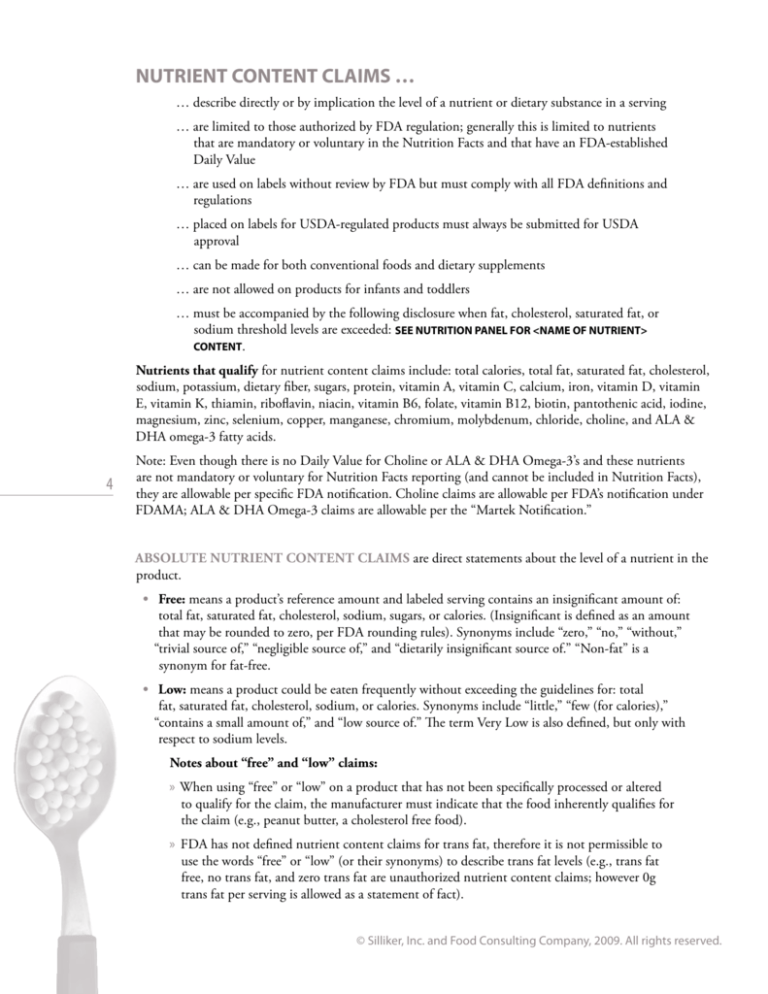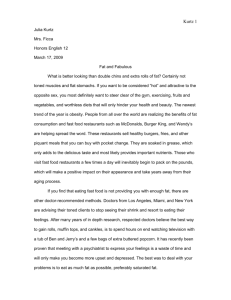
NUTRIENT CONTENT CLAIMS …
… describe directly or by implication the level of a nutrient or dietary substance in a serving
… are limited to those authorized by FDA regulation; generally this is limited to nutrients
that are mandatory or voluntary in the Nutrition Facts and that have an FDA-established
Daily Value
… are used on labels without review by FDA but must comply with all FDA definitions and
regulations
… placed on labels for USDA-regulated products must always be submitted for USDA
approval
… can be made for both conventional foods and dietary supplements
… are not allowed on products for infants and toddlers
… must be accompanied by the following disclosure when fat, cholesterol, saturated fat, or
sodium threshold levels are exceeded: SEE NUTRITION PANEL FOR <NAME OF NUTRIENT>
CONTENT.
Nutrients that qualify for nutrient content claims include: total calories, total fat, saturated fat, cholesterol,
sodium, potassium, dietary fiber, sugars, protein, vitamin A, vitamin C, calcium, iron, vitamin D, vitamin
E, vitamin K, thiamin, riboflavin, niacin, vitamin B6, folate, vitamin B12, biotin, pantothenic acid, iodine,
magnesium, zinc, selenium, copper, manganese, chromium, molybdenum, chloride, choline, and ALA &
DHA omega-3 fatty acids.
4
Note: Even though there is no Daily Value for Choline or ALA & DHA Omega-3’s and these nutrients
are not mandatory or voluntary for Nutrition Facts reporting (and cannot be included in Nutrition Facts),
they are allowable per specific FDA notification. Choline claims are allowable per FDA’s notification under
FDAMA; ALA & DHA Omega-3 claims are allowable per the “Martek Notification.”
Absolute Nutrient Content Claims are direct statements about the level of a nutrient in the
product.
• Free: means a product’s reference amount and labeled serving contains an insignificant amount of:
total fat, saturated fat, cholesterol, sodium, sugars, or calories. (Insignificant is defined as an amount
that may be rounded to zero, per FDA rounding rules). Synonyms include “zero,” “no,” “without,”
“trivial source of,” “negligible source of,” and “dietarily insignificant source of.” “Non-fat” is a
synonym for fat-free.
• Low: means a product could be eaten frequently without exceeding the guidelines for: total
fat, saturated fat, cholesterol, sodium, or calories. Synonyms include “little,” “few (for calories),”
“contains a small amount of,” and “low source of.” The term Very Low is also defined, but only with
respect to sodium levels.
Notes about “free” and “low” claims:
»» When using “free” or “low” on a product that has not been specifically processed or altered
to qualify for the claim, the manufacturer must indicate that the food inherently qualifies for
the claim (e.g., peanut butter, a cholesterol free food).
»» FDA has not defined nutrient content claims for trans fat, therefore it is not permissible to
use the words “free” or “low” (or their synonyms) to describe trans fat levels (e.g., trans fat
free, no trans fat, and zero trans fat are unauthorized nutrient content claims; however 0g
trans fat per serving is allowed as a statement of fact).
© Silliker, Inc. and Food Consulting Company, 2009. All rights reserved.
»» FDA has not defined nutrient content claims for carbohydrate, therefore it is not permissible
to use the words “free” or “low” (or their synonyms) to describe carbohydrate levels (e.g., no
carbs, carb free, and low carb are unauthorized nutrient content claims; however Xg carb per
serving is allowed as a statement of fact as long as it is simply a repeat of information from
the Nutrition Facts and does not imply a level).
»» FDA has not provided a definition for “low sugar,” therefore this claim cannot be used;
however, manufacturers can use “sugar free,” ”reduced sugar,” and “no added sugar” claims
as long as food also qualifies as a low calorie food or includes the “not a low calorie food”
disclaimer.
»» If a claim is made about fatty acids or cholesterol, then polyunsaturated fat and
monounsaturated fat must be included in the Nutrition Facts (or Supplement Facts) unless
the product in fat free; additionally, specific disclosure about total fat and cholesterol levels
must be included directly next to the claim when certain threshold levels are exceeded.
»» For dietary supplements: claims for total fat, saturated fat, and cholesterol can be made only
if the product is greater than 40 calories per serving, and claims for calories can be made only
when a similar product exists that contains over 40 calories per serving.
• Lean: may be used to describe meat, poultry, seafood, and game meat and means less than 10g fat,
4.5g or less saturated fat, and less than 95mg cholesterol per reference amount or per 100 grams
(whichever is larger). Criteria are different for mixed foods, meals, and main dishes.
• Extra Lean: may be used to describe meat, poultry, seafood, and game meat and means less than 5g
fat, less than 2g saturated fat, and less than 95mg cholesterol per reference amount or per 100 grams
(whichever is larger). Criteria are different for mixed foods, meals, and main dishes.
• Good Source: means the reference amount of a product contains 10 to 19% of the Daily Value of
a particular nutrient (i.e., fiber, protein, or a vitamin or mineral). Synonyms include “contains” and
“provides.”
• High: means the reference amount of a product contains 20% or more of the Daily Value for a
particular nutrient (i.e., fiber, protein, or a vitamin or mineral). Synonyms include “excellent source”
and “rich in.”
Notes about “good source” and “high” claims:
»»“Good source” and “high” cannot be used to describe nutrients and functional components
without an FDA-established Daily Value (i.e., cannot be used to describe carotenoids,
flavonoids, etc.).
»» The term “antioxidant” can be used in a claim as long as the antioxidant is named, it has an
FDA-established Daily Value, and its level qualifies for the “good source” or “high” claim (i.e.,
high in antioxidant vitamin C).
»» If a fiber claim is made and the food does not qualify as a low fat food, then the fiber claim
must be accompanied by a disclaimer that discloses the level of total fat per labeled serving.
»» If a protein claim is made, then the Nutrition Facts (or Supplement Facts) must include the
% Daily Value from protein based on the protein-digestibility corrected amino acid score
(PDCAAS).
• High Potency: means the vitamin or mineral is present in a product at 100% or more of the RDI per
reference amount and must identify the nutrient in the claim (e.g., high potency vitamin C). “High
Potency” can also be used to describe a conventional food or dietary supplement when the product
contains 100% or more RDI for at least two-thirds of vitamins and minerals with Daily Values
present in the product at 2% or more (e.g., high potency multivitamin/mineral supplement).
© Silliker, Inc. and Food Consulting Company, 2009. All rights reserved.
5
Nutrient Content Claim Definitions for “Free and Low”
Nutrient
Calories
Total Fat
Saturated Fat
Cholesterol
6
Sodium
Claim
Free
Low
Definition
Less than 5 calories per serving
40 calories or less per serving
Main dish/meal product: 120 calories or less per 100 grams
Free
Less than 0.5g fat per serving, and includes no ingredients that
contain fat (unless asterisked in the ingredient statement and
footnoted “*adds a trivial amount of fat”)
Low
3g or less fat per serving
Main dish/meal product: 3g or less fat per 100 grams, and not
more than 30% of calories from fat
Free
Less than 0.5g saturated fat and less than 0.5g trans fat per
serving, and includes no ingredients that contain saturated fat
(unless asterisked in the ingredient statement and footnoted
“*adds a trivial amount of saturated fat”)
Low
1g or less saturated fat per serving, and not more than 15% of
calories from saturated fat
Main dish/meal product: 1g or less saturated fat per 100 grams,
and less than 10% of calories from saturated fat
Free
Less than 2mg cholesterol and 2g or less saturated fat per
serving, and includes no ingredients that contain cholesterol
(unless asterisked in the ingredient statement and footnoted
“*adds a trivial amount of cholesterol”)
Low
20mg or less cholesterol and 2g or less saturated fat per serving
Main dish/meal product: 20mg or less cholesterol and 2g or
less saturated fat per 100 grams
Free
Less than 5mg sodium per serving, and contains no sodium
chloride (table salt) or other ingredient that contains sodium
(unless asterisked in the ingredient statement and footnoted
“*adds a trivial amount of sodium”)
Very Low 35mg or less sodium per serving
Main dish/meal product: 35mg or less sodium per 100 grams
Low
140mg or less sodium per serving
Main dish/meal product: 140mg or less sodium per 100 grams
“Per serving” means per reference amount or per labeled serving, whichever is larger. However, if a product has a
small serving size (i.e., reference amount of 30 grams or less or 2 Tbsp or less), then the nutrient levels for the claim
must be met on a 50 gram basis.
© Silliker, Inc. and Food Consulting Company, 2009. All rights reserved.









